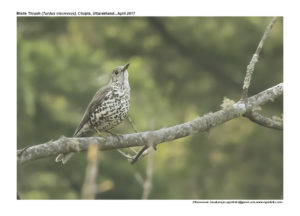Mistle Thrush

Mistle Thrush Turdus viscivorus
Etymology:
- Turdus : Latin word for Thrush
- Viscivorus : Latin word visci – mistletoe; voruseating
Vernacular Name: Kash: Techalkastur
Distribution in India: Resident of West Himalayas in India.
Description: Size of 26-27 cm. It is a large, long-tailed, rather pale thrush. The nominate race is brownish-grey above, with buffy-olive rump, narrow whitish wingbars and greyish flight-feathers, tail with white distal outer feathers and tips. It is whitish below, with darker vertical smudge below eye and on rear ear-coverts, extensive but often rather sparse black spotting and sometimes a darkish patch at breast side. The underwing-coverts are white, the bill is dark with yellowish base and legs are pinkish. Both the sexes are similar.
Habitat:It is found in mosaic of wooded and open country, open mature forest, woodland glades, orchards, riverside forest, open grassland with scrub, mountain steppe with shrubs, often penetrating grassy-bracken moorland areas on low craggy hills and mountains at some distance from Found at 1200 to 3000 m.
Food habits: It eats invertebrates, seeds and fruits. Animal food includes adult and larval beetles, adult and larval crane flies, adult and larval lepidopterans, orthopterans, earwigs, bugs, spiders, millipedes , snails, slugs, earthworms and rarely, small vertebrates, including nestling birds. Plant food includes mainly fruits and seeds. It forages on ground in open or under semi-open canopy, or in trees for fruit.It sometimes sallies after flying insects, and to snatch fruit from ends of twigs.
Breeding habits: They breed in Mar to Jun in W & C Europe, and Apr in N Finland, Mar to Jul in Afghanistan E to W Himalayas; Mar–Jun in NW Africa and W Himalayas. The nest is a large cup of dry grass, plant stems, roots and moss, bound together with mud, lined with fine grasses and sometimes pine needles up in fork of tree. They lay a clutch of 3–5 eggs. The incubation period is 12–15 days. Thenestling period is 14–16 days and young are capable of flight at 20 days. The post-fledging dependence is15–20 days. The male taking responsibility for young when second clutch is laid.